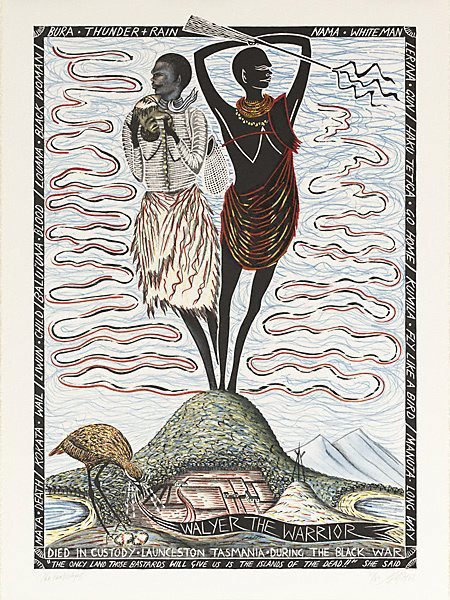Ann Marie McMahon, The Two Walyers
ANNE-MARIE MCMAHON (Australia, b.1953)
“The Two Walyers” (from the portfolio “The Bicentennial Folio of Prints by Twenty Five Australian Artists”) 1988 Colour lithograph Edition: 80 69.0 x 48.6 cm image; 76.2 x 57.2 cm sheet Acquired: 2003 (as part of the portfolio) #Inventory/Catalogue No. |
|
Biography:
Ann-Marie McMahon is widely known for her ‘poster’ style art, which is essentially limited-edition prints of varying techniques, i.e. screenprints and lithographs. The ‘poster-style’ attribution emanates from the political, social and environmental content inherent to the works.
McMahon’s childhood years were spent living on naval bases in Australia, and for a period in the 1960s, the Philippines, before her family finally settled in Sydney.
She spent time at the Tin Sheds Art Workshop at the University of Sydney, and worked collaboratively, producing a catalogue of posters. With this experience McMahon moved on to a design role at Redback Graphix, a design and screen-printing studio based in Sydney. From 1979 to 1994, Redback Graphix produced posters that combined witty graphics with intense colours to give voice to a raft of pressing social issues – from AIDS awareness, alcohol abuse and human rights through to the promotion of local film screenings and benefit gigs. Cross-cultural issues were also provided a voice, with McMahon and her colleagues, producing the poster “You are on Aboriginal Land”, “Beat the Grog” and “Condonman” an AIDS awareness campaign.[1]
McMahon worked in the Tiwi Islands from 1988 until 1996 and from 2000 to 2001 at Gunbalanya, Arnhem Land, where she produced a series of collages interpreting the landscapes around her. Her most recent works, from 2009-10, have dealt with political conflict in Indochina and Cambodia. [2]
Artwork:
“The Two Walyers” is part of the “Bicentennial Portfolio”, comprising works by 25 Australian artists, produced in response to the Bicentenary of Australia in 1988. The term “walyer” loosely translates as ‘rebel’ or ‘warrior’ with the two figures striking combative poses, circumscribed by a frame of text, and representing a particularly tragic series of events in Australian history, specifically, the conflict between the British colonists and Indigenous Australians of Tasmania (1820s to 1832).
[1] Zagala, Anna, Redback Graphix, National Gallery of Australia, Canberra, 2008
[1] Artist Profile, Museum of Contemporary Art, Sydney,


